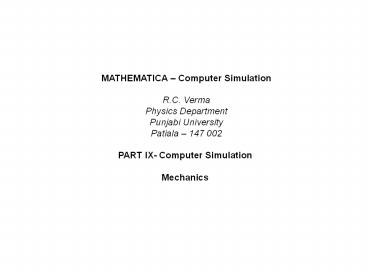MATHEMATICA - PowerPoint PPT Presentation
1 / 24
Title: MATHEMATICA
1
MATHEMATICA Computer Simulation R.C.
Verma Physics Department Punjabi
University Patiala 147 002 PART IX- Computer
Simulation Mechanics
2
INTRODUCTION
- Traditionally physics teaching comprises of
theory lectures based on analytical techniques
and conventional laboratory experiments. - Despite the importance of computational physics,
it has been largely neglected in the
conventional physics curricula. - Now with the availability of personal computers,
it has become possible to introduce this
important branch in the physics curricula.
3
What PC can do?
- PC offers new opportunities for innovative
learning. - It provides highly interactive, individual and
creative learning. - It can help to approach wide variety of problems
and phenomena than is possible with only analytic
tools. - It can also be used to develop physical intuition
and ability to estimate physical quantities
involved in a phenomena. - NMEICT (MHRD, Govt. of India)- Rs. 4,612 crores
Mission
4
Questions
- For practical purposes of PC into physics we
need to answer- - How to use PC to improve physics teaching?
- What other changes will come after we introduce
PC to the physics curricula? - Could advances of research into physics learning
be incorporated into new Curricula? - Can the new curricula reflect contemporary
physics?
5
OBJECTIVES OF PHYSICS TEACHING
- i) Number awareness
- ii) Experimental skills
- iii) Analytic skills
- iv) Scales and estimations
- v) Approximations skills
- vi) Numerical skills
- vii) Intuition large problem skills
6
Applications of Computer for Physics?
- Problem Solving
- Demonstrations and Tutorials (CAI)
- Data analysis using Spreadsheets
- Simulation of Physics Problems
- Graphics and Animation
- Magnification of Instruction
7
Problem Solving
- PC can be used easily and interactively through
a variety of high-level languages, - They offer numerical power sufficient for even
initiating research-level problems. - Many numerical programming languages are already
with us BASIC, FORTRAN, and C - Recently, Symbolic Computational languages
Mathematica, MatLab, MathCad, Macsyma - capable of dealing with algebra, differential and
integral calculus, and powerful graphics tools. - This obviously enhances the scope of physics
problems to be handled on a PC.
8
Simulation of Physics Problems
- The corner stone of computing is building a model
of an idea through simulation. - It can deliver real time sequence on the screen.
- We can simulate real world phenomena that are
prevented from studying in the laboratory due to
constraints of time, expense, danger and
feasibility. - E.g. Planetary Motion, Nuclear Reactor, Interior
of Sun - We can try models that don't occur in real world
to seewhat the implication would be. - E.g. What would happen if we change the
gravitational force law a little?
9
Present Status in Physics Curricula
- Computational physics has largely been neglected
in the standard physics curricula. - Main factors 1. Lack of computing hardware 2.
Lack of teaching-material besides 3. Lack of
trained human resource. - Situation is slowly improving.
10
COMPUTER SIMULATION OF PROBLEMS (Methodology)
- Physics ? Algorithm ? Program ? Results
- Computer Hardware and Software
- Numerical analysis
- Development of algorithms for problems
- Developments of programs for simulation
- Results and Error analysis.
11
Steps to solving Physics Problem
- Identify the input variables- like parameters
of a physical system initial conditions of
thesystem and time interval step size of
time evolution. - Identify the output variables-
solution of the problem. - Construct the equations to connect the
input variables to the output variables. - Re-express the equations using numerical
techniques. - Write algorithm/flowchart to solve the problem.
- Develop Programs (I/O, common arithmetic
operations and logical structures
Sequential, Repetitive and Selective). - Execute the program on a computer.
12
Performing Computer Experiments
- Run computer experiments to study effects of
- change of step size used in discretization of
continuous independent variable - change of initial conditions of the physical
system - change of physical parameters of the system.
- changes due to errors,
- stability and limitations of the numerical tools.
13
One Dimensional Motion
- A spherical body falling in viscous medium
14
(No Transcript)
15
(No Transcript)
16
(No Transcript)
17
Damped Oscillator
- Equation of motion is
18
Clear"Global" ( Find Analytic solution
) k 3.0 ( spring constant ) m 1.0 (
mass attached to the spring ) w0 Sqrtk/m c
0.5 damp c/m x01.0 v0 1.0 ( initial
conditions ) tmin 0tmax 5 ndsolDSolve
x''tdampx'tw02 xt0,
x0x0, x'0v0, xt, t//Chop//Flatten
19
( Plot the solution for a given time interval
)p1 Plot xt/.ndsol, t,tmin, tmax,
AxesLabel-gt"t-gt", "x", PlotLabel-gt"Harmonic
Motion"
20
vt_ Dxt/.ndsol, tp2 Plot vt, t,tmin,
tmax, AxesLabel-gt"t-gt", "v",
PlotLabel-gt"velocity", PlotStyle-gt
Dashing0.02
21
at_ Dvt, tp3Plot at, t,tmin, tmax,
AxesLabel-gt"t-gt", "a", PlotLabel-gt"accelerat
ion", PlotStyle-gt Dashing0.05
22
Showp1, p2, p3
23
ParametricPlot xt/.ndsol, vt ,
t,tmin, tmax , AxesLabel-gt"x", "v",
PlotLabel-gt"phase_space_trajectory"
24
Thank you!































